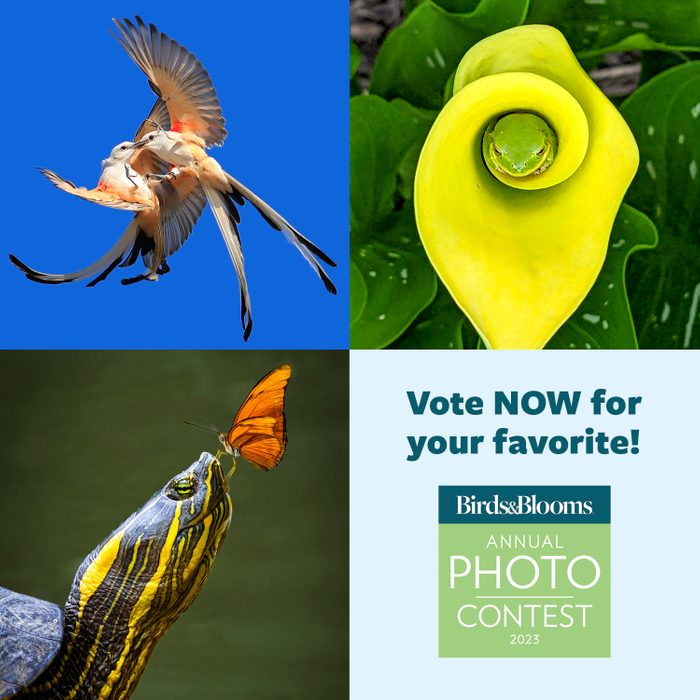
Every year, we invite readers to send us their best bird, bloom and butterfly photos for our annual Birds & Blooms Photo Contest.
For our 2023 contest we received thousands of extraordinary entries. Our editorial team narrowed it down to 12 finalists. From there, we turned it over to you to vote for your favorites. We are happy to announce that our readers voted for Conrad Peloquin’s gorgeous and unique photo of a turtle and a butterfly as the grand prize winner.
The Story Behind the Winning Photo
![Bnbpc23 Conrad Peloquin[1] Copy](https://www.birdsandblooms.com/wp-content/uploads/2024/01/BNBPC23_Conrad-Peloquin1-copy.jpeg?fit=700%2C1024)
In his original contest submission, Conrad said, “While I find this shot special in its own right, it is the story behind the shot that makes it even better. The story begins years earlier. My wife would spot what she deemed to be a good photo, and when alerting me to it, if I didn’t agree, I’d say, ‘Nah, it’s just a bird on a branch… now if it had a butterfly on his nose, that would be a good shot,’ ‘Nah, it’s just an alligator head, nothing special… now if it had a butterfly on his nose, that would be a good shot.’ This fun banter has gone on for years. It is always my nice way of saying that my wife’s visually interesting potential photo is not to my liking.
Conrad continues, “Fast forward to recently. While we were on a river boat in Costa Rica, our guide was pointing out interesting things. At one point he said, ‘There is a turtle on a log up ahead.’ To this, you can guess what I said. Onward 10 minutes, and our guide again said there was a turtle with a butterfly on his nose ahead. My wife and I laughed. He continued to tell us how butterflies land on turtles’ to get salt. Again, we laughed, as we thought he was embellishing. Then, we saw it! We couldn’t believe it. Our guide hadn’t been joking at all. Now, I tell my wife that her uninteresting shots need to have two butterflies on the nose.”
Check out the 2023 Spring Birding Moments video contest winners.
How to Enter Your Photo
Thanks for the thousands of Birds & Blooms readers who submitted entries and voted for their favorite pictures in the 2023 Photo Contest. Here’s some more exciting news! We have even more contests planned, including the 2024 Photo Contest.
Check our contests page for more details on how to enter upcoming and current contests and to read the official rules.
Next, don’t miss the amazing winner of the 2022 Birds & Blooms Photo Contest.
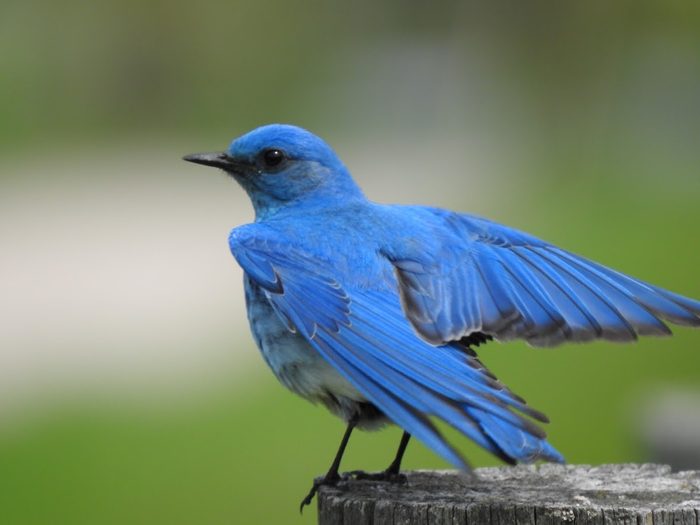
The birds in our gardens or local parks can feel like old friends after a while. It may seem as if we’re seeing the same individuals year after year—and that may be true because often they stay faithful to their home territory. But it can lead us to wonder: How long do birds live? That question can be surprisingly hard to answer.
How Long Do Birds Live in Captivity?
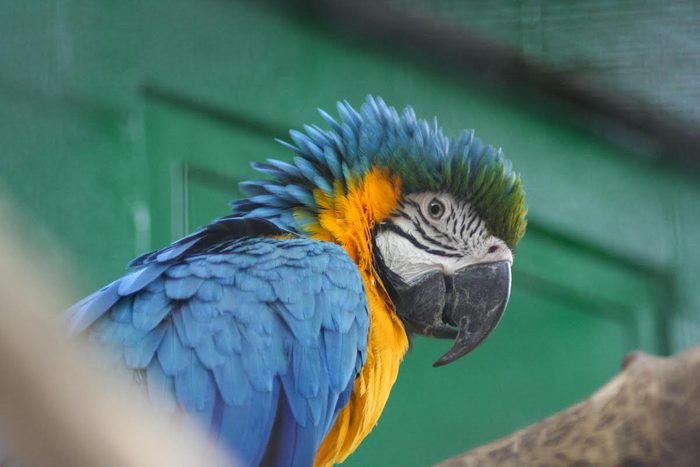
After a bird reaches its adult plumage, it’s impossible to tell how old it is just by looking at it. But some zoos and aviaries keep records of individual birds, which means we can track their ages.
One example: A pink cockatoo (a type of Australian parrot) arrived at the Brookfield Zoo near Chicago in 1934. When he died in 2016, he was at least 83 years old. It’s also been claimed that some other parrots, especially large ones like cockatoos and macaws, have reached over 100 years old. Some probably have, but it’s difficult to be sure without complete documentation.
Birds in good zoos, protected from predators and with access to veterinary care, may live longer than those in the wild. Aside from large parrots, some other zoo birds that have lived more than 60 years include flamingos and Andean condors.
How Long Do Birds Live in the Wild?
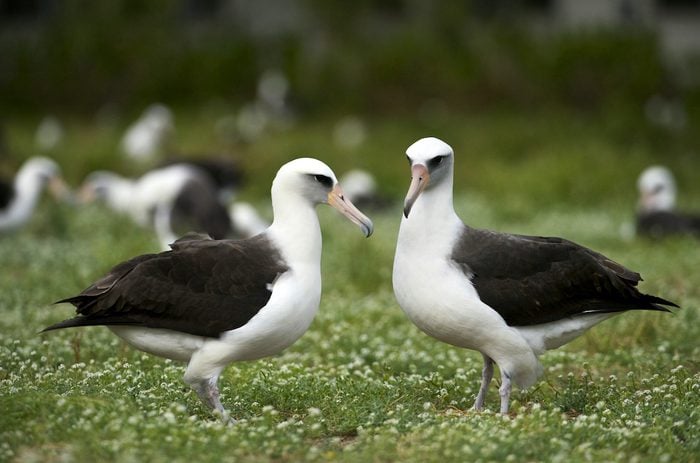
Most of what we know about life spans of wild birds comes from banding studies. A numbered band placed on a bird’s leg makes it possible to identify the bird. Currently, the oldest known wild bird is Wisdom, a banded Laysan albatross that returns every year to her nest on Midway Atoll in the North Pacific. Even though she’s more than 70 years old, she has continued to raise young in recent years.
Banding records tell us of other birds with long life spans in the wild. Sandhill cranes and bald eagles can live more than 35 years. Canada geese, Atlantic puffins and some large gulls might reach more than 30 years old. Mallards, great horned owls and mourning doves can live longer than 25 years.
For most small songbirds, the maximum known life spans are between eight and 15 years. But the average life spans for all these birds are shorter than the all-time records.
How long do hummingbirds live?
Does Bird Size Affect Lifespan?
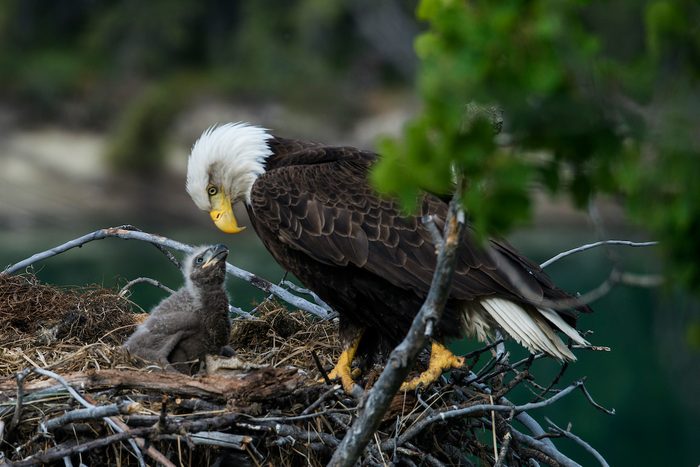
As shown by these examples, bigger birds tend to live the longest. But there are exceptions. Birds like grouse and pheasants that live on the ground tend to have shorter life spans. Wild turkeys, weighing up to 20 pounds, seldom live much longer than 10 years, and the same is true for tiny hummingbirds.
Long-lived birds often reproduce very slowly. A pair of albatrosses or condors will raise no more than one chick every one or two years, so the adults have to live a long time to leave enough offspring to maintain their populations.
By contrast, many small songbirds raise two or three broods yearly, laying four or five eggs in every clutch. While the birds in our gardens and at our feeders may live only a few years, their descendants will keep us company for a long time in the future.
Find out what types of birds mate for life.
How to Help Birds Live Longer
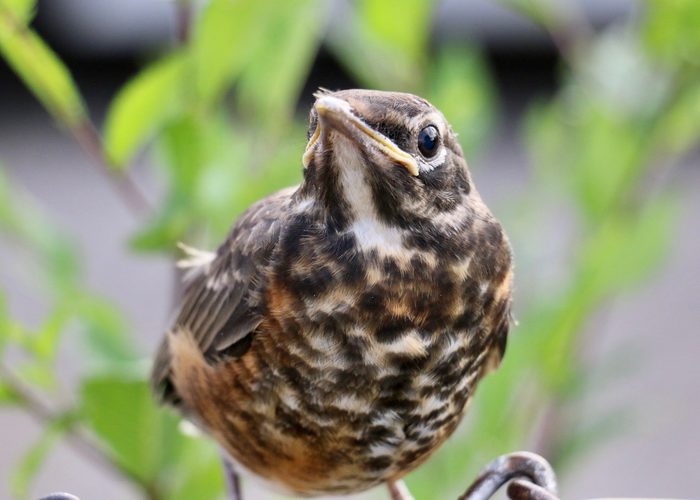
The most dangerous time in the lives of many songbirds is just after they leave the nest. You can make a space for these vulnerable fledglings by planting dense low shrubs, avoiding using lawn chemicals and not allowing house cats to roam outdoors.
If you see a baby bird on the ground, it’s best to stay back and leave it alone; the parent birds are probably nearby.
Why Trust Us
For nearly 30 years, Birds & Blooms, a Trusted Media Brand, has been inspiring readers to have a lifelong love of birding, gardening and nature. We are the #1 bird and garden magazine in North America and a trusted online resource for over 15 million outdoor enthusiasts annually. Our library of thousands of informative articles and how-tos has been written by trusted journalists and fact-checked by bird and garden experts for accuracy. In addition to our staff of experienced gardeners and bird-watchers, we hire individuals who have years of education and hands-on experience with birding, bird feeding, gardening, butterflies, bugs and more. Learn more about Birds & Blooms, our field editor program, and our submission guidelines.
On This Page
What Does a Costa’s Hummingbird Look Like?
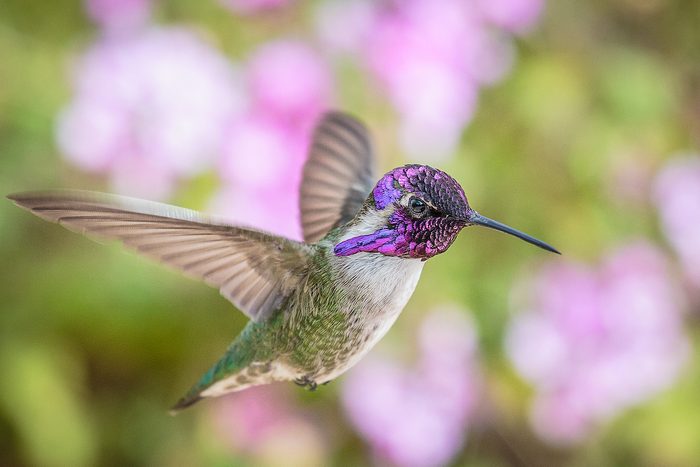
Measuring only 3½ inches long, the Costa’s hummingbird is a pint-sized delight in its arid habitats, weighing in at only one-tenth of an ounce.
The male has a hunched appearance with a stubby tail, and is easily identified by its green back and iridescent purple on its head and around its throat. “This is a very small species of hummingbird, all-green back with no rufous (brown) coloration. The underside is light colored, light gray on the flanks to white on the belly, and, in females, a white chin. Adult males have a brilliant purple throat and crown (top of head),” says Christopher Clark, assistant professor of biology at the University of California, Riverside.
Meet more types of hummingbirds found in the United States.
Female Costa’s Hummingbird
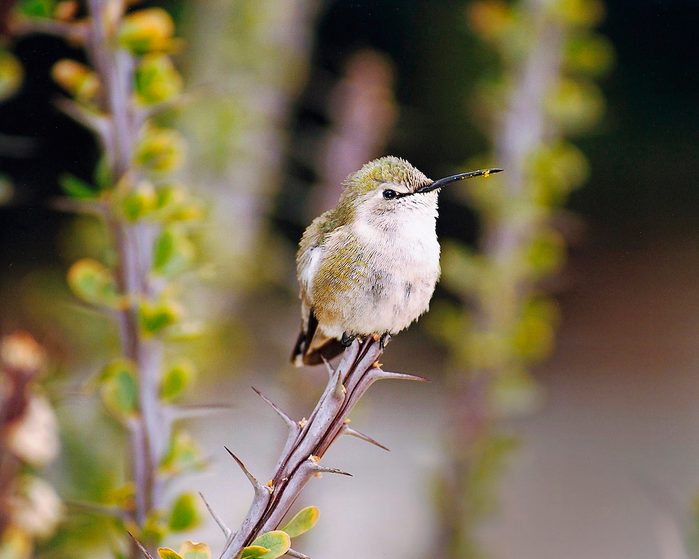
The green and white females look similar but lack the bold purple throat and head feathers of the males. To identify them, look for a gray cheek patch and a white eyebrow.
Juvenile
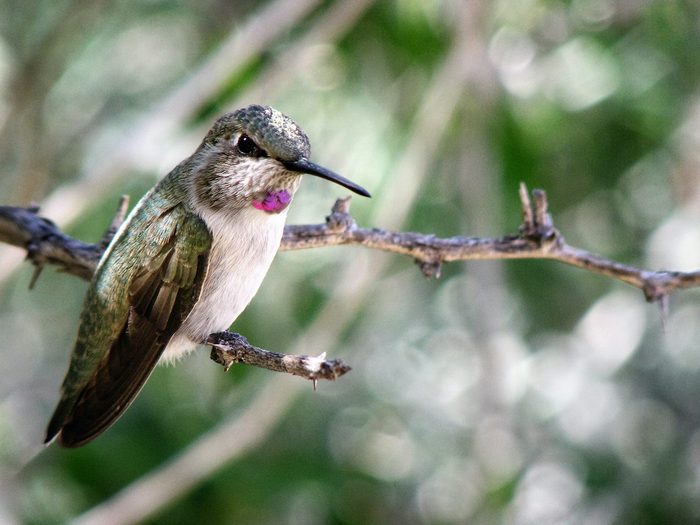
Birding experts Kenn and Kimberly Kaufman say, “Young male hummingbirds are tricky to identify, because they’re often somewhere between the appearance of a female and an adult male.”
Reader Steve Dummermuth Jr. asks, “I took this photo (above) near Scottsdale, Arizona. I think it’s an immature male, but is it a black-chinned or an Anna’s?”
Kenn and Kimberly say, “We think this is a young male Costa’s hummingbird for several reasons. The dark outline of the throat patch, extending down and back below the eye, is very typical of Costa’s at this stage, and so is the patch of pinkish purple on the lower throat. Also, the breast and sides are clear whitish—most Anna’s and black-chinneds show more of a gray-green wash on the sides.”
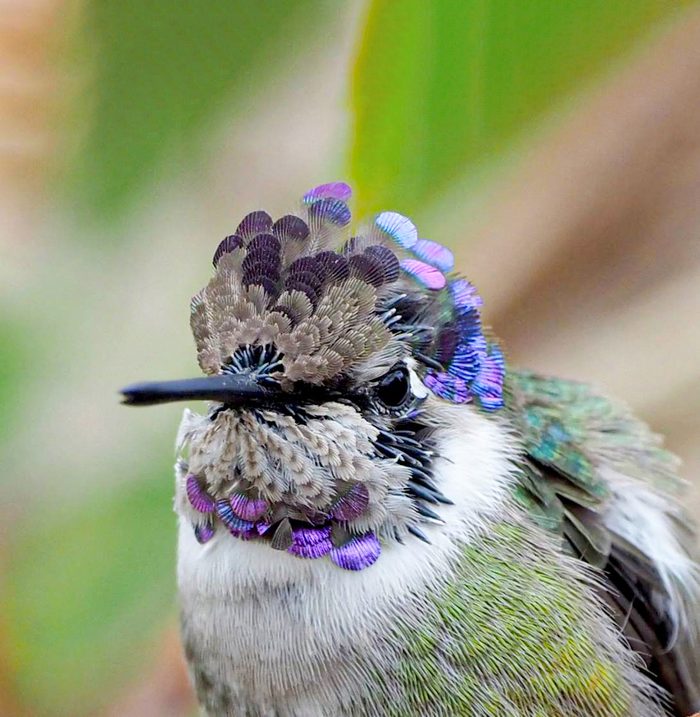
“One of my favorite photos ever was of this young Costa’s hummingbird (above) just getting in his beautiful feathers,” says reader Lisa Swanson.
Call and Sounds
Male Costa’s hummingbirds are regular singers, making a thin, piercing whistle. With other species, the most common sounds are aggressive calls, which resemble chattering or squealing. You’ll hear them when several hummingbirds are gathered near a food source such as a sugar-water feeder.
Bird songs courtesy of the Cornell Lab of Ornithology.
Courtship Displays
Christopher says the Costa’s unique breeding ritual involves a male flying directly in front of a female, flaring his purple feathers and creating the appearance of a baby octopus on his head. Another display entails repeated looping dives on either side of the female while singing. Christopher says their song is of a remarkably high frequency, and their narrow feathers make a practically identical sound.
A male Costa’s hummingbird can amplify the sound of his tail feathers by 11 decibels by directing the angle of those feathers toward the female during the courtship rituals.
“A male performs shuttle displays in which he flies back and forth right in front of the female with the iridescent purple gorget flared, so that he looks like an amazing little star. He also does a dive in which he ascends 100 feet up in the air and then descends in a huge oval, making a high pitched eeeEEEEEeeee! sound with his tail as he dives,” Christopher says.
Heart Rate
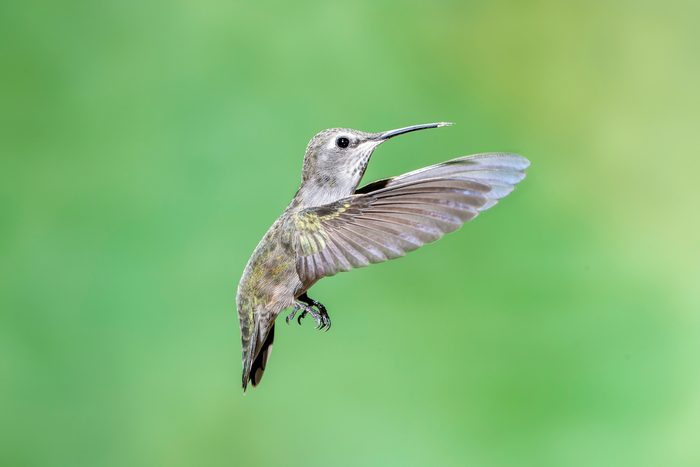
During normal daily activity, the heart rate of Costa’s hummingbirds ranges between 500 and 900 beats per minute. When the temperature drops below 50 degrees, the birds enter a torpor, and their heart rate slows to around 50 beats per minute.
Nesting Habits
Like other types of hummingbirds, the female Costa’s does all of the nest building and parenting work herself.
“After mating, the female goes off on her own,” Christopher says. Combining bits of leaves, lichen and bark, she creates a cupped nest with a 11/4-inch diameter, and “she’ll use a bunch of spiderwebs to glue the nest together.” Inside, there is fluff to keep the eggs warm.
Christopher says she’ll lay two eggs the size of jelly beans that weigh 0.4 grams apiece. “Each egg equals 20% of her body mass and is incubated for 14 to 18 days.”
After hatching, the chicks are fed insects by the female for the first two weeks. “The last week, she will feed them nectar,” Christopher says.
He notes that where people are providing consistent food sources, like feeders and gardens, the birds may extend their breeding season and begin nesting as early as the fall months, enabling them to raise multiple broods in a year.
Learn more about the fascinating life of a female hummingbird.
How to Attract Costa’s Hummingbirds
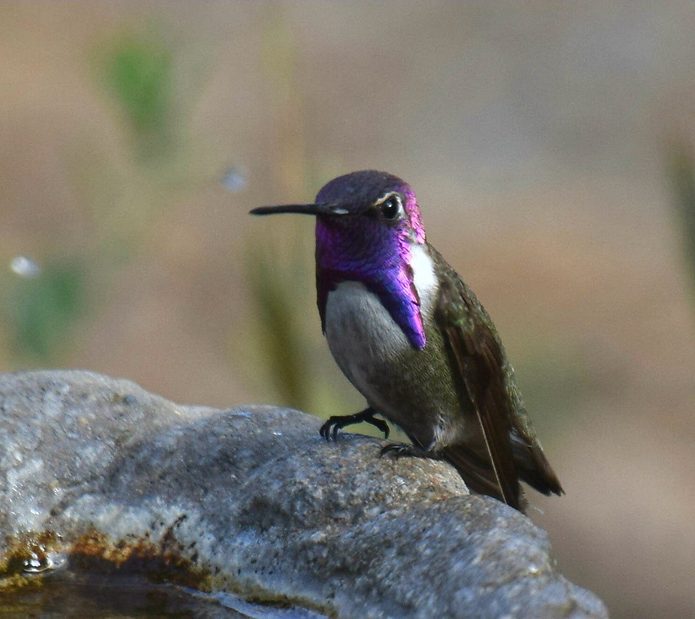
To catch a glimpse of these vivacious hummingbirds, put up one or two sugar-water feeders and add some native plants to your landscape. “People in the desert do have them in their backyard,” Christopher says. “These birds love feeders.”
As for nectar plants to attract them, he says Costa’s are attracted to chuparosa and ocotillo shrubs, but “there are a lot of nonnatives that they love. Salvias, such as Mexican sage, are favorites,” he says.
Then listen for their distinctive high-pitched call or watch for the male’s flashy violet facial markings.
Range and Migration
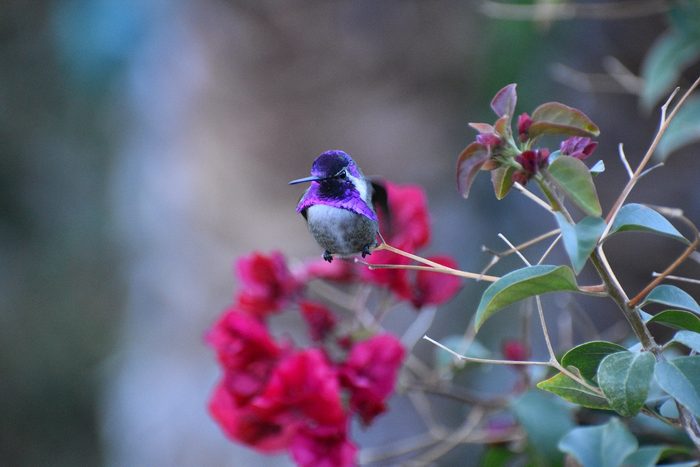
To see these birds, you’ll need to look in the southwestern states.
Partly residing in the Sonoran and Mojave deserts in March and April, Costa’s thrive in the heat, says Christopher. However, they wander toward the sagebrush scrub communities of coastal California to escape the most intense heat beginning in May.
Christopher says, “They breed in the winter, starting in low elevation Sonoran desert. Later in the spring (April) they shift to sage scrub habitat. When the breeding season ends by late June, they wander. It’s not clear how far they go, or whether this wandering should be considered to be an actual migration. In some places, they remain all year-round. They return to their breeding areas in approximately November, when the chuparosa flowers begin to bloom in the desert.”
How Did the Costa’s Hummingbird Get Its Name?
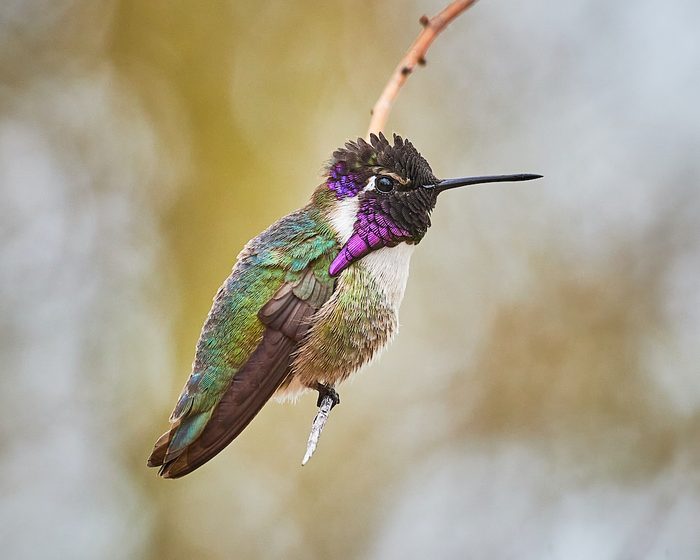
It was named in honor of Louis Marie Pantaléon Costa, Marquis de Beauregard, a French nobleman. The bird was collected on an expedition of the French ship Vénus, which stopped in Baja, California, and a French hummingbird biologist, Jules Bourcier, named it after the Marquis.
Costa’s Hummingbird Hotspot
Tohono Chul Park lies within the Sonoran Desert in Tucson, Arizona. This park provides easy walking trails and gardens to view some of the 140 bird species that visit the 49-acre site. A hummingbird garden attracts Anna’s, broad-billed and Costa’s hummingbirds year-round to sip nectar from salvia, desert willow and other plants. Migration brings rufous, broad-tailed, calliope and black-chinned hummers.
Why Trust Us
For nearly 30 years, Birds & Blooms, a Trusted Media Brand, has been inspiring readers to have a lifelong love of birding, gardening and nature. We are the #1 bird and garden magazine in North America and a trusted online resource for over 15 million outdoor enthusiasts annually. Our library of thousands of informative articles and how-tos has been written by trusted journalists and fact-checked by bird and garden experts for accuracy. In addition to our staff of experienced gardeners and bird-watchers, we hire individuals who have years of education and hands-on experience with birding, bird feeding, gardening, butterflies, bugs and more. Learn more about Birds & Blooms, our field editor program, and our submission guidelines.
Sources
- Kenn and Kimberly Kaufman, official birding experts for Birds & Blooms
- Dr. Christopher J. Clark, hummingbird researcher and assistant professor of biology at the University of California, Riverside
- Cornell Lab of Ornithology
- https://abcbirds.org/bird/costas-hummingbird/
- https://tucsonaudubon.org/bird_profile/costas-hummingbird/
- https://www.audubon.org/news/watch-male-costas-hummingbirdputs-one-wild-mating-display
- https://www.altaonline.com/dispatches/a5704/hummingbirdresearch-riverside/
- https://www.fs.usda.gov/detail/r3/plants-animals/wildlife/?cid=FSEPRD571072

Northern mockingbirds may not be the flashiest birds in your backyard, but they’re some of the most talkative. Learn more about what mockingbirds eat and how you can attract them to your backyard, if they aren’t there already!
On This Page
What Do Mockingbirds Eat?
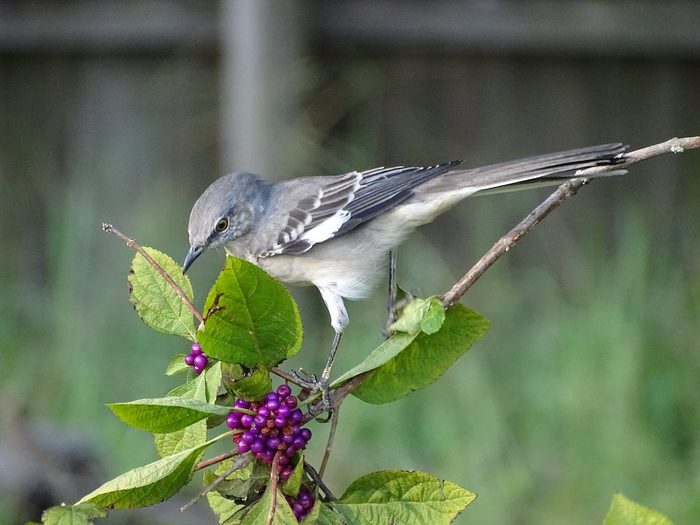
Northern mockingbirds are big berry fans. Attract them with ornamental berry bushes like elderberry, blackberry, juniper and pokeweed.
As omnivores, northern mockingbirds eat insects such as grasshoppers, caterpillars and beetles in summer, and rely on berries in winter.
Although it’s uncommon for northern mockingbirds to stop by seed feeders, you may entice them to your yard with a suet feeder or with sliced fruit like oranges and apples.
Learn how to identify and attract a gray catbird.
Do Mockingbirds Visit Bird Feeders?

Do Mockingbirds Eat Suet?
“Is it normal for a northern mockingbird to regularly visit suet feeders?” asks Birds & Blooms reader Thomas Faust of Brooklyn, New York.
Birding experts Kenn and Kimberly Kaufman say, “Northern mockingbirds are not typically feeder birds. Their usual diet is insects as well as small fruits, so standard feeder items such as seeds and suet won’t attract them most of the time. But they are flexible and adaptable in their behavior.
After watching birds stop by for suet, a mockingbird may investigate and discover that it’s a good food source. From then on, that individual may become a regular customer, even as other mockingbirds may ignore the feeder.”
Are Mockingbirds Bullies at Bird Feeders?
“Mockingbirds sit by my feeder and scare away other birds, especially bluebirds. How can I discourage them from doing this?” asks reader Linda Howard of Lexington, South Carolina.
Kenn and Kimberly say, “Mockingbirds aren’t usually frequent visitors at bird feeders, so it could be that the ones you’re seeing are defending something else nearby, such as a fruiting tree or shrub. If that’s the situation, you could resolve the conflict by relocating the feeder to a different spot.
If you have mockingbirds coming to your feeder regularly for something like mealworms or suet, try offering these items in smaller amounts at two or three different locations so the aggressive mockers can’t dominate all of them.”
Meet the brown thrasher: an elusive, musical songbird.
Backyard Tips for Attracting Northern Mockingbirds
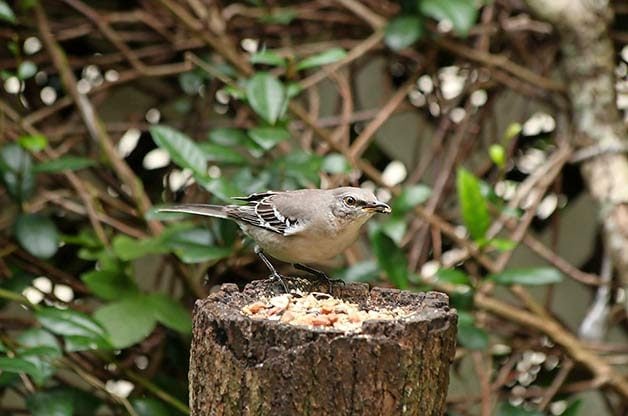
“To attract mockingbirds, I purchase unsalted roasted peanuts and chop them very fine in my food processor. As soon as a mockingbird sees the peanuts on the feeding logs, it swoops in. This particular mockingbird (above) didn’t even mind me sitting a few feet away, taking photos,” says reader Doreen Damn of New Port Richey, Florida.

“We don’t have to work too hard to get mockingbirds in our yard. They are everywhere! They’ve never taken to our feeders, but they do like our berry bushes: blueberry, dogwood, raspberry, pyracantha, etc. Whatever berries are in season, the mockingbirds are first in line at the buffet!” says reader Arlene Tencza of Waxhaw, North Carolina.
Sources
Kenn and Kimberly Kaufman, official birding experts for Birds & Blooms
Why Trust Us
For nearly 30 years, Birds & Blooms, a Trusted Media Brand, has been inspiring readers to have a lifelong love of birding, gardening and nature. We are the #1 bird and garden magazine in North America and a trusted online resource for over 15 million outdoor enthusiasts annually. Our library of thousands of informative articles and how-tos has been written by trusted journalists and fact-checked by bird and garden experts for accuracy. In addition to our staff of experienced gardeners and bird-watchers, we hire individuals who have years of education and hands-on experience with birding, bird feeding, gardening, butterflies, bugs and more. Learn more about Birds & Blooms, our field editor program, and our submission guidelines.
On This Page
What Does a Spotted Towhee Look Like?

A male spotted towhee has a black head, back and tail with a white belly, orange-red sides and multiple white wing marks. A female looks similar, but has gray or brown accents instead of black. Both males and females have red eyes.
- Scientific Name: Pipilo maculatus
- Family: Sparrow
- Length: 8-1/4 inches
- Wingspan: 10-1/2 inches
- New Name: Older field guides show the rufous-sided towhee as a single widespread species. Researchers split this species into the eastern towhee and spotted in 1995.
Meet the towhees: The birds scratching up a storm in your backyard.
Spotted Towhee vs Eastern Towhee

“I was told this is an eastern towhee, but I live in the San Joaquin Valley in California. Is it?” asks Birds & Blooms reader Michael Caskey of Fresno, California.
Birding experts Kenn and Kimberly Kaufman say, “The eastern towhee is replaced in the western states by a close relative, the spotted towhee. These two species are very similar, but the spotted towhee has more white markings on the wings and usually some white spots on the back. In your photo (above), we can see just enough of the white in the wing to be sure that this is the spotted towhee, not the eastern.
This species can be found year-round in your area of California, although it’s more common in the mountains in summer and down in the valleys during winter.”
Nest and Eggs
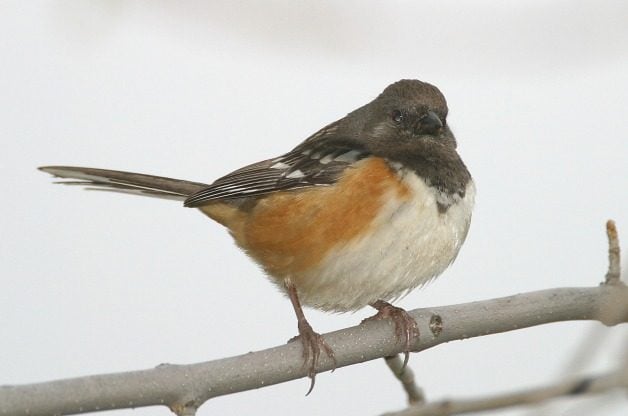
This bird builds a nest on or near the ground using leaves, stems, pine needles and more. The female lays two to six gray, white, pinkish or greenish speckled eggs.
All about sparrows: What birders should know.
Spotted Towhee Song

This species sings a wide variety of songs, which typically feature high-pitched introductory notes followed by a trill. The bird also makes a buzzy rapid trill.
Listen to the spotted towhee’s song.
Bird songs provided by the Cornell Lab of Ornithology.
What Do Spotted Towhees Eat?

Their diet primarily consists of insects, spiders, caterpillars, seeds, berries; sometimes small lizards or snakes. Backyard favorites include oats or seeds scattered on the ground, as well as suet.
Learn how to identify a chipping sparrow and a song sparrow.
Range Map and Habitat

Look for these birds in old pastures, woodland edges and brushy backyards in states west of the Mississippi River. Some birders in the west can see this species year-round, but the birds that spend summer in the northernmost part of their range do migrate in winter.
Birds & Blooms reader Neal Zaun writes, “The spotted towhee inhabits many areas of western North America. The species tends to prefer forest edges, thickets and shrubby park areas.”
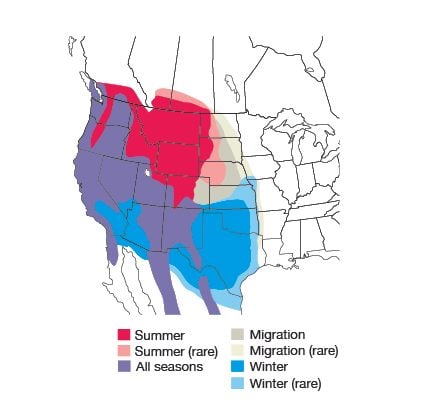
Range maps provided by Kaufman Field Guides, the official field guide of Birds & Blooms.
Next, meet the white crowned sparrow and white throated sparrow.
Why Trust Us
For nearly 30 years, Birds & Blooms, a Trusted Media Brand, has been inspiring readers to have a lifelong love of birding, gardening and nature. We are the #1 bird and garden magazine in North America and a trusted online resource for over 15 million outdoor enthusiasts annually. Our library of thousands of informative articles and how-tos has been written by trusted journalists and fact-checked by bird and garden experts for accuracy. In addition to our staff of experienced gardeners and bird-watchers, we hire individuals who have years of education and hands-on experience with birding, bird feeding, gardening, butterflies, bugs and more. Learn more about Birds & Blooms, our field editor program, and our submission guidelines.
Sources
- Kenn and Kimberly Kaufman, Kaufman Field Guides
- Cornell Lab of Ornithology
- Project NestWatch
On This Page
What Does a Violet-Crowned Hummingbird Look Like?
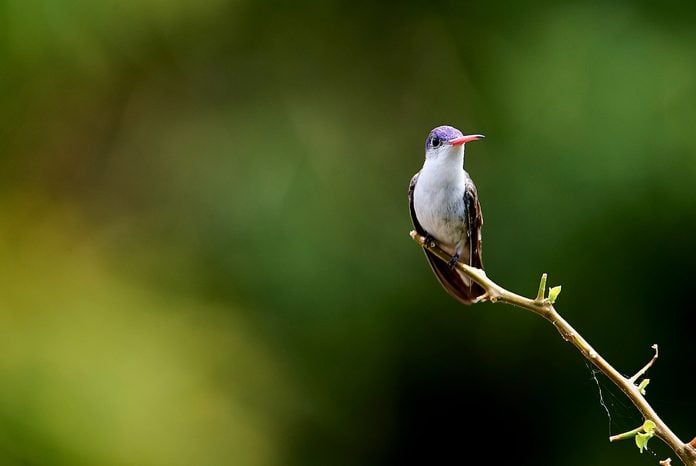
Both male and female violet-crowned hummingbirds measure about 4 inches with snowy white underparts. No other U.S. hummingbird shares the starkly white unmarked belly, throat, and flanks. The bronze-greenish back can appear grayish under some light conditions.
The crown, nape, and face are purplish, sometimes appearing violet-blue or even more blue than purple, and varying in intensity among individuals. A bright red bill with a black tip adds a splash of color to these striking birds.
Adult males and females are essentially indistinguishable. Females may have a slighter duller-colored crown than males. But there is so much overlap in shading of the crown that plumage alone is not a reliable indicator of sex.
Juveniles are paler, often appearing plain gray above and white below.
Typically about 11 cm in length, the violet-crowned hummingbird is one of the largest hummers found in the U.S. It is noticeably larger than other species that are common in southernmost Arizona and New Mexico, such as the broad-billed and black-chinned hummingbird. However, it is smaller than the Rivoli’s hummingbird and blue-throated mountain-gem.
How to Attract Violet-Crowned Hummingbirds
Violet-crowns feed on nectar from many different plants, especially those with bright-colored tubular flowers.
If you live within their range, consider planting species that are native to the region, including various species of red salvia, firecracker bush (Bouvardia ternifolia), scarlet betony (Stachys coccinea) and bat-faced cuphea. These hummingbirds also feed on agave flowers and various flowering trees. When landscaping, always try to leave native plants and native plant communities intact.
These birds also readily come to feeders.
Violet-Crowned Hummingbird Range
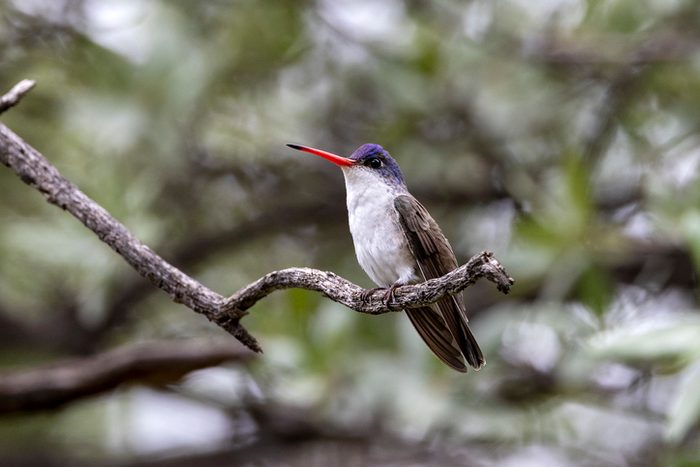
Primarily a Mexican species, the violet-crowned hummingbird reaches the northern limit of its range in extreme southeast Arizona and adjacent southwest New Mexico. Its presence in the U.S. is relatively recent, with the first recorded nesting north of Mexico confirmed in 1959.
Increasingly the violet-crowned hummingbird is both nesting in and overwintering within its narrow range in Arizona and New Mexico, perhaps due the prevalence of hummingbird feeders.
The birds do not occur in Texas or California except as very rare vagrants, with just a few records for those two states.
Learn how to identify a Costa’s hummingbird.
Migration
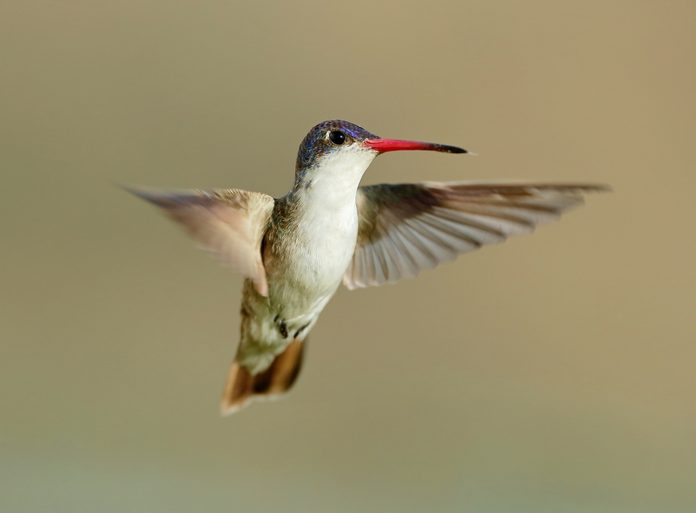
In the northern part of their range, violet-crowned hummers are considered at least partially migratory.
Little is known of their migratory habits, but the breeding season runs from April into August. Northward migration occurs primarily in late winter and early spring and southward migration occurs from mid-summer through mid-autumn.
Migrating birds reach their U.S. range by the first half of June and depart in August and September. However, some individuals arrive earlier and stay later or even all year.
Some seem to partake in migration-like “wandering” outside of the breeding season. Individuals can show up nearly any time within or close to the expected range.
Do hummingbird sightings have special meaning?
Hummingbird Hotspot
The easiest, most reliable location to observe a violet-crowned hummingbird is at the Tucson Audubon’s Paton Center for Hummingbirds in Patagonia, Arizona.
According to the Paton Center, more people have first laid eyes on this species at this location than anywhere else on the planet. In recent years, a small number birds have been observed overwintering there.
For information, visit www.tucsonaudubon.org/paton-center/.
Check out jaw-dropping facts about hummingbirds.
Violet-Crowned Hummingbird Nest
This species is generally riparian. According to the Cornell Lab of Ornithology, almost all nests in Arizona and New Mexico are found some 20 to 40 feet above ground in sycamore trees.
Most observed nests are constructed of whitish cotton-like down plant material bound with spiderwebs and camouflaged with lichen and other plant debris. The cup shape and its construction is similar to other hummingbird nests.
There is virtually no data on violet-crowned hummingbird nesting behavior. For most hummingbird species, eggs hatch in 14 to 19 days. Young fledge in about 3 to 3 1/2 weeks.
Find out why hummingbirds are the ultimate bird supermoms.
Violet-Crowned Hummingbird Song
Listen for their song of soft but piercing high-pitched notes, cheer-cheeer-cheeer-cheeer-cheeer. Calls, especially at dawn, include a kissing chip-chip-chip.
Little is known about its courtship behavior. No displays have been recorded other than persistent singing, presumably by males on conspicuous perches.
Learn more about the many sounds of hummingbirds.
Bird songs courtesy of the Cornell Lab of Ornithology.
Behavior
Violet-crowned hummingbirds will actively chase away other species, especially in the absence of multiple nectar sources. They can dominate smaller species. They often select a favorite perch to use routinely.
Why Trust Us
For nearly 30 years, Birds & Blooms, a Trusted Media Brand, has been inspiring readers to have a lifelong love of birding, gardening and nature. We are the #1 bird and garden magazine in North America and a trusted online resource for over 15 million outdoor enthusiasts annually. Our library of thousands of informative articles and how-tos has been written by trusted journalists and fact-checked by bird and garden experts for accuracy. In addition to our staff of experienced gardeners and bird-watchers, we hire individuals who have years of education and hands-on experience with birding, bird feeding, gardening, butterflies, bugs and more. Learn more about Birds & Blooms, our field editor program, and our submission guidelines.
Sources
- The Hummingbird Handbook: Everything You Need to Know About These Fascinating Birds
- Tucson Audubon’s Paton Center for Hummingbirds
- Cornell Lab of Ornithology
On This Page
Mourning Dove Nesting Habits
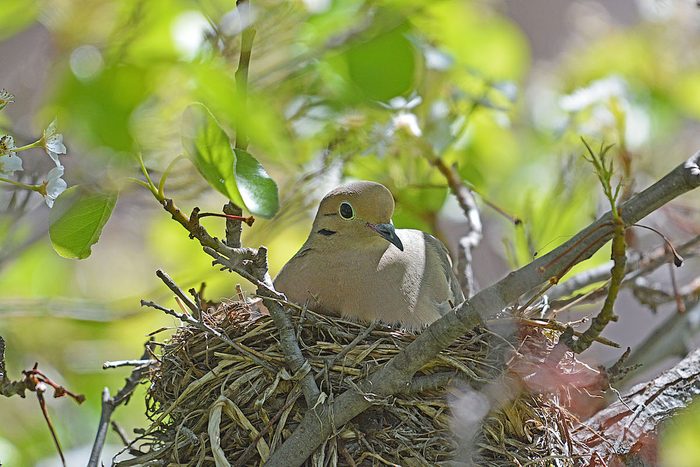
Most birds spend several days, to as long as two weeks getting their home just right. But a pair of mourning doves can quickly throw together a loose platform of sticks in just a few hours. The construction may be finished in a single morning or spread over a couple of days. The male is prone to interrupting the work to pursue the female. A flimsy nest mourning dove nest is made of pine needles, twigs and grass.
Check out more fascinating facts about mourning doves.
Where Do Mourning Doves Nest?
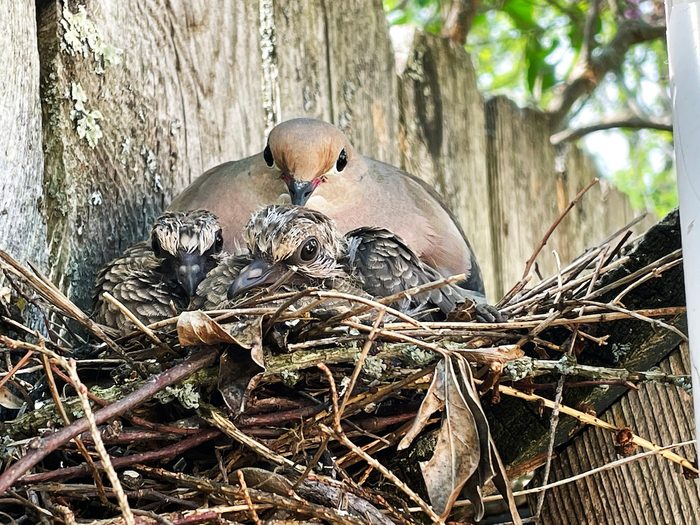
“I feed doves, finches and sparrows. How do I get these birds to nest in my yard?” asks Birds & Blooms reader Peggy Shreve of Oceanside, California.
Birding experts Kenn and Kimberly Kaufman say, “The only way to attract nesting birds is to provide the right nest sites, as different birds choose different situations for placing their nests. Doves often build on top of a horizontal fork in a tree.”
These birds also often choose protected spots on the ledges of houses for their twiggy nests. Mourning doves do not use nest boxes.
Find out if mourning dove sightings have meaning.
How Long Until Mourning Dove Eggs Hatch?
“A mourning dove built a nest near my front door. How long until the eggs hatch?” asks reader Aspasia Simeone of Long Beach, New York.
Kenn and Kimberly say, “After the pair finishes building the nest—which takes two to four days—the female usually lays the first egg within a couple of days, and a second egg a day or two later. Both parents will take turns incubating the two eggs. The eggs hatch after 14 days. Both parents feed the youngsters, and they will be ready to fly in about two weeks.”
Do mourning dove feathers and wings make noise?
Why Do Mourning Doves Build Nests so Early in Spring?
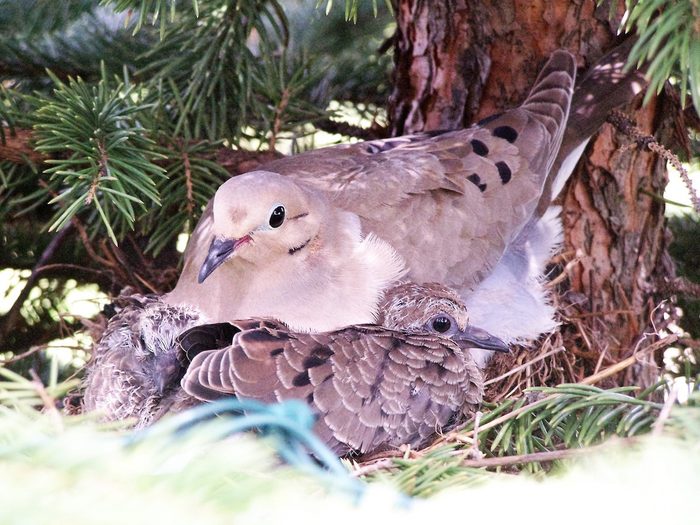
A Birds & Blooms reader from Manahawkin, New Jersey, wrote in to ask why these birds get such an early start on nest building.
Kenn and Kimberly say, “That’s a good observation—they do start nesting early in the season. Even in the north they may start their first nest as early as March. In southern states, doves may begin in February or even January. And a pair of mourning doves makes repeated nesting attempts during the year, sometimes raising as many as five broods between March and October. Normally they just lay two eggs per brood.”
Psst—don’t miss these breathtaking photos of mourning doves.
Why the hurry? Kenn and Kimberly explain, “Mourning dove nest construction is so flimsy that the eggs or baby birds sometimes fall out. So the mourning doves may have an instinct to try over and over to make sure they raise enough young to keep the species going.”
Did you know: Mourning doves and other birds that nest in the open usually (but not always!) build a new nest for each brood.
Learn what a mourning dove call sounds like.
Why Trust Us
For nearly 30 years, Birds & Blooms, a Trusted Media Brand, has been inspiring readers to have a lifelong love of birding, gardening and nature. We are the #1 bird and garden magazine in North America and a trusted online resource for over 15 million outdoor enthusiasts annually. Our library of thousands of informative articles and how-tos has been written by trusted journalists and fact-checked by bird and garden experts for accuracy. In addition to our staff of experienced gardeners and bird-watchers, we hire individuals who have years of education and hands-on experience with birding, bird feeding, gardening, butterflies, bugs and more. Learn more about Birds & Blooms, our field editor program, and our submission guidelines.
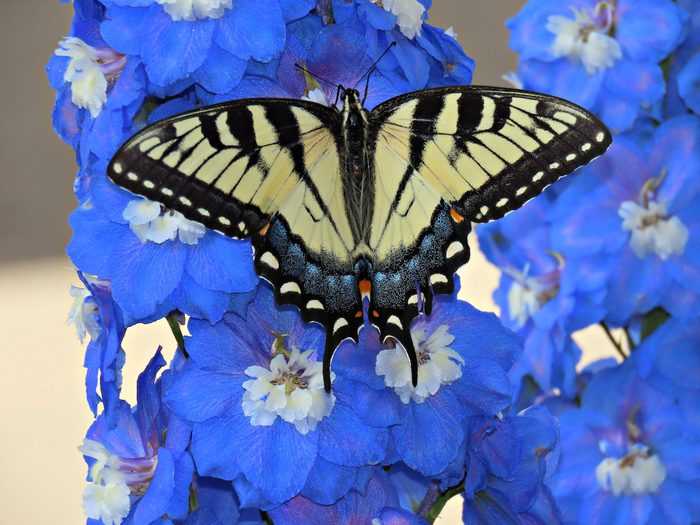
My favorite flowers in the garden are often the blue ones. There’s something about seeing this cool hue mixed among the brighter yellows, reds, and oranges that always makes me fall in love. One of the truest blues you can find in a flower garden comes from delphinium, especially some of the newer cultivars on the market. If you love blue too, you’ll want to give growing delphiniums (also known as larkspur) a try. They can be a little tricky, so here are a few tips.
On This Page
Delphinium Care and Growing Tips
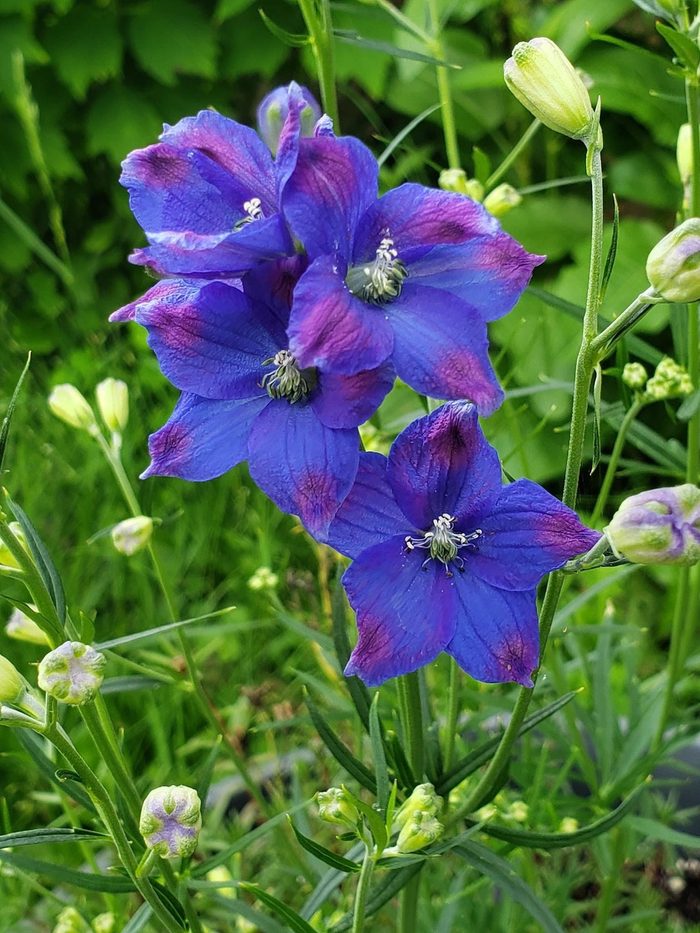
- Scientific name: Delphinium spp.
- Common name: Larkspur
- Zones: 3 to 7
- Light needs: Full sun
- Well-draining soil
- Attracts: Hummingbirds, butterflies, bees
Although it’s a bit picky, larkspur is well worth the effort when spires of blue flowers reach for the sky. Delphiniums require full sun and organic, moist, well-draining soil. Don’t allow the soil to dry out. Mix in compost before planting and fertilize regularly.
Larkspur plants grow 2 to 6 feet tall. This towering treasure makes a statement at the back of a mixed border, as a vertical accent or in a container. Stake taller varieties to stand up to wind and rain.
Cut delphiniums back hard after their first blooming to encourage a second late summer or fall bloom. Remove spent flower stems completely. This is often considered the trick to growing delphiniums successfully.
Delphiniums are happiest with cool moist weather. Hot dry summers are often their downfall. Because of this, many gardeners prefer growing delphiniums in the spring and early summer as annuals, replacing them each year. They can be grown as perennials in zones 3 to 7. In cooler zones, grow delphiniums in full sun. In warmer climates, afternoon shade will help them endure hotter weather.
Meaning of Delphinium
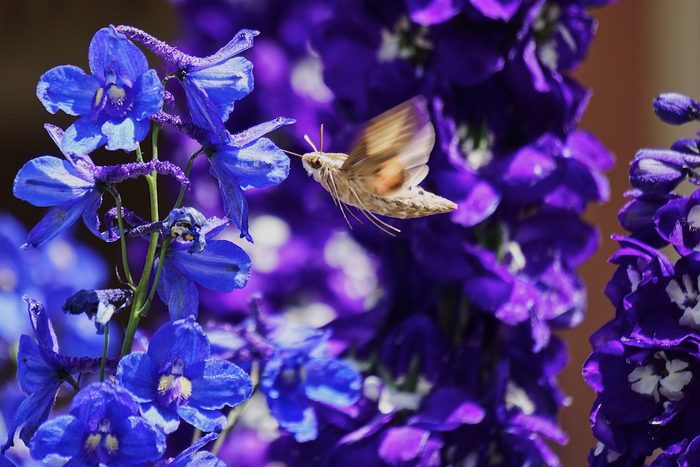
The word delphinium means “dolphin-like,” and refers to the graceful shape of the nectary at the base of each bloom. Delphiniums are also known as larkspur in many places. This also refers to the shape of the bloom, which is thought to resemble the claw on a lark’s foot.
Pollinator Benefits
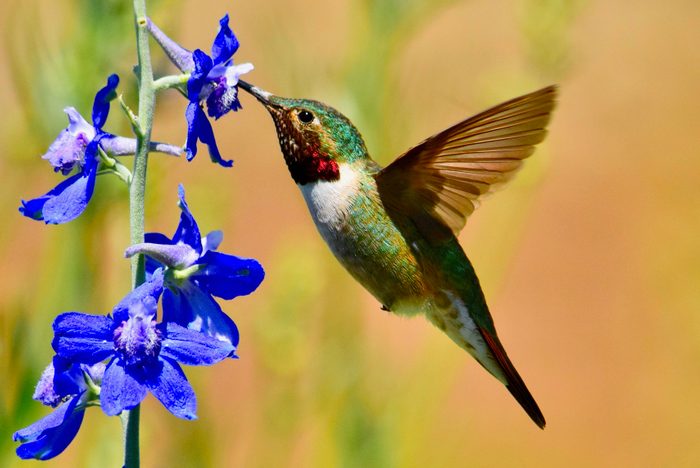
With dozens of blooms on each stem, it gives hummingbirds plenty of nectar sources to share with butterflies and other bugs, too.
However, be careful when furry friends and children are around. This plant, particularly the sprouts, is toxic to pets, livestock (and people).
Delphinium Varieties
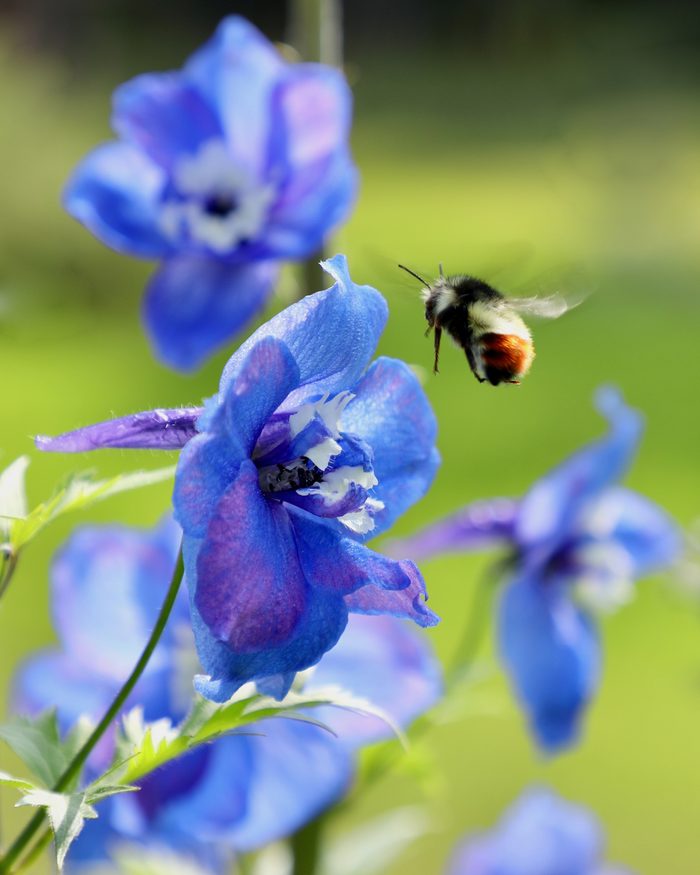
Delphiniums are a large family of over 300 species. They can be found throughout the northern hemisphere, and on high mountains in Africa. They come in a range of colors, including pink and white, but most people think of the blue varieties when they think of this flower. Many types are quite tall and become droopy with rain or wind, but newer dwarf varieties stand up to those challenges pretty well.
Some varieties, like the Summer Blues, are a lot bluer than others. For heat tolerance, try the Blue Mirror cultivar. Dasante Blue is a great choice for a cutting garden. Grab your shears and snip a few stems to bring a little beauty to your house.
Native Larkspur
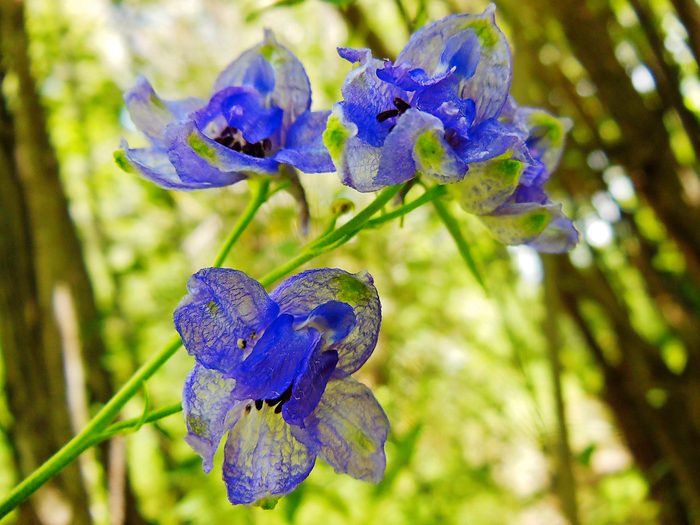
“I spotted this delicate flower (above) that is kind of transparent and a very pretty blue-purple color. What could it be?” asks Birds & Blooms reader Kit Warner of Mule Creek, New Mexico.
Horticultural expert Melinda Myers says, “You’ve found native larkspur, most likely Delphinium nuttallianum. This particular larkspur is more common in open areas and dry conditions. There are several other very similar delphiniums that are distinguished by their location and more subtle features. As the blue petals pass their peak, they start to fade and develop the transparency you’ve captured in this photo.”
Backyard Tip: Delphinium exaltatum, or tall larkspur, is native in the East and sturdy enough to grow in Zones 4 to 8.
Sources
- Melinda Myers
- U.S. Department of Agriculture
- Ball Horticultural Company
- U.S. Forest Service
- North Carolina State Extension
On This Page
What Does a Tennessee Warbler Look Like?
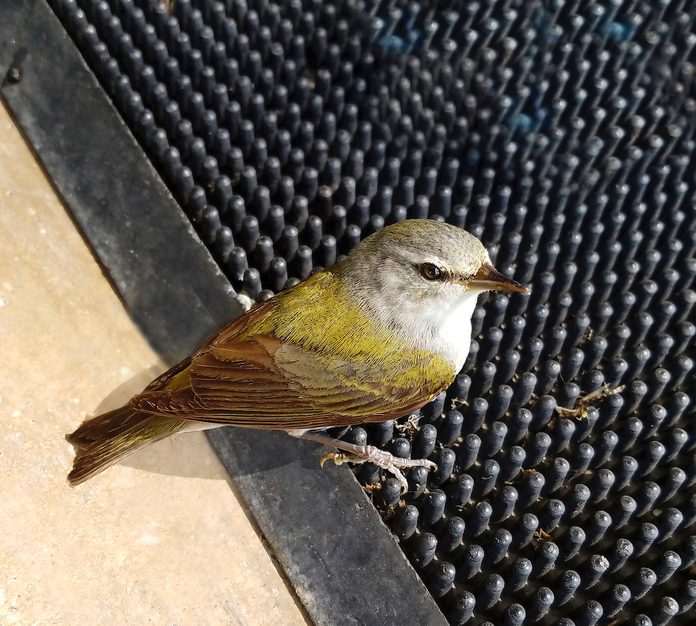
“This bird flew into my window one afternoon and was dazed. It sat for a bit before flying away. What species is it?” asks Joyce Sorensen of Clear Lake, Iowa.
Birding experts Kenn and Kimberly Kaufman say, “We are happy to clear up the mystery. Your surprised visitor is a male Tennessee warbler. The keys to recognizing it are the small size, thin bill, white eyebrow on a gray head and bright yellow-green back.”
Females and juveniles are more yellow but appear duller.
Mystery Warbler Identification
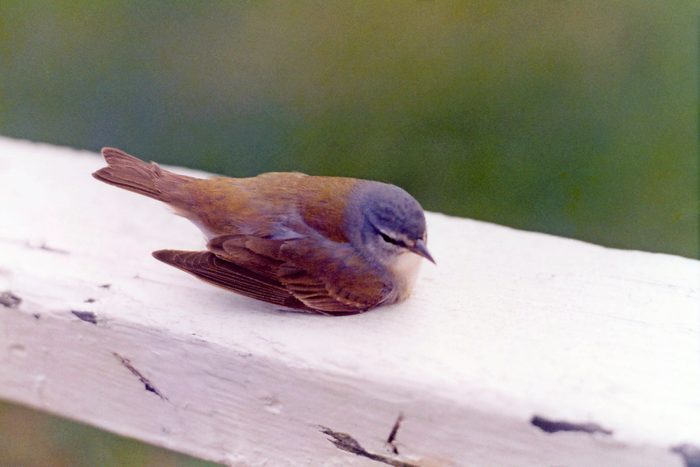
“This photo is from 1974, but the bird is still a mystery. What is it?” asks reader Judith Clayton of Alexandria, Minnesota.
Kenn and Kimberly say, “We are happy to clear up the mystery. This is a male Tennessee warbler. The very thin, pointed bill places it in the warbler family, and the male Tennessee has the same pattern as yours: blue-gray cap, white eyebrow, dark line through the eye, white throat and an olive green back that contrasts with the gray head.
Despite its name, this warbler migrates through Tennessee only in spring and fall. It spends the summer mostly in Canada and winters in Central America. The one that visited you in Minnesota was probably passing through on migration.”
Range and Habitat
Don’t be fooled by this bird’s name. According to Kenn and Kimberly, like the Nashville warbler, this warbler doesn’t have any special connection to the state of Tennessee. It’s a migratory bird, spending summers mostly in Canada and flying to the tropics of Central America for the winter. It passes through Tennessee (and Iowa) only during its travels in spring and fall.
Diet
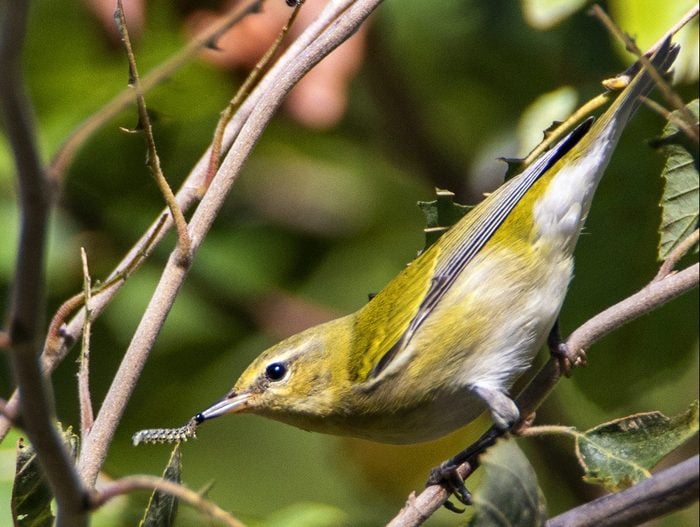
Tennessee warblers are especially fond of caterpillars. In winter, they also feed on fruit, berries and flower nectar.
Many migrants, like warblers or kinglets, bypass feeders on their journeys north. To find these insect-eating spring specialties, head to a wooded area or body of water where birds are likely to stop and rest before continuing on to their breeding grounds.
Learn more birding tips for warbler migration and the top warbler hotspots to visit in spring.
Sound
Bird songs courtesy of the Cornell Lab of Ornithology.